Fulham arrived into the Premier League as one of the favourites to go straight back down, after failing to retain their top-flight status in numerous previous attempts. However, things seem to be different this year, after they have continued to repeatedly put in good performances.
The Cottagers sit in 9th place going into the World Cup break, off the back of back-to-back brilliant performances against both Manchester City and Manchester United, although coming out of both games bitterly disappointed after conceding the deciding goal in the last minute of injury time in both instances.
7 of Fulham’s 24 Premier League goals this season have been scored from set pieces, where they rank 2nd in the Premier League in that regard. This has been one of the big reasons for their increased points output, although it would be unfair to disregard their brilliance in open play as well.
Aleksandr Mitrovic has scored 9 goals up until now, even after missing a number of games due to injury. He has particularly benefited from the brilliant set-piece routines that facilitate him to consistently get chances in front of goal which allow his brilliant finishing to come to light, something that used to be overlooked due to his limited opportunities in front of goal.
In this tactical analysis, we will delve into the tactics Marco Silva has used to make Fulham so dangerous from corners and free kicks. The set-piece analysis will show just how much variety Fulham have in these situations, which makes them prepared for every scenario and unpredictable for opponents. Furthermore, the analysis will look into the movement and routines used to score so many set-piece goals.
Use of blocks/screens
One of Fulham’s most effective methods of creating space for players to head the ball is through setting up blocks. Blockers are players whose purpose is to prevent opponents from getting to the ball, and they have no intention of heading the ball themselves.
During outswinging corners, Fulham aim for the area between the penalty spot and the six-yard box. This is an area which is too far for goalkeepers to be able to claim crosses while being in a good position from where Fulham can still score a goal.
Against teams which zonally mark the six-yard box, Marco Silva has used blockers to make the zonal markers ineffective. The three Arsenal players who start on the six-yard line are all blocked by Fulham players who are small and unlikely to win an aerial duel. This allows each Fulham player to have a 1v1 attempt on getting onto the end of a cross from just outside the six-yard area. When teams mark zonally, their big men stay deep while smaller players individually man mark the threats.
As a result, in the image below, Mitrovic is left alone against Gabriel Jesus who, while he is tenacious, doesn’t have the ability to compete with Mitrovic in aerial duels. This would be a nightmare scenario for any player, as Mitrovic is one of the most physical and strongest headers of the ball in the world. When left 1v1, Mitrovic will beat most players in the world to a header, and so this use of blockers to leave the Serbian brute alone has been one of the key methods to creating chances from corners for Fulham all season.
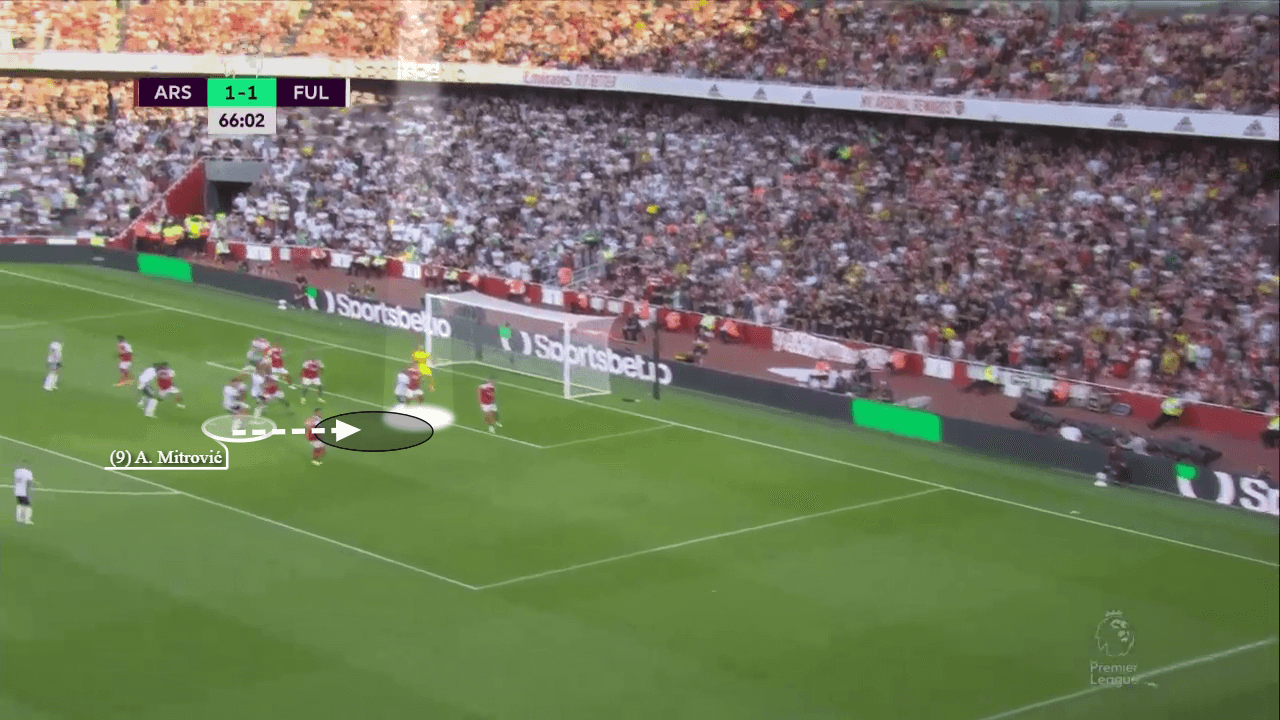
Fulham have utilised blocks in numerous ways this season. In the scenario below, Fulham use a blindside block, where Mitrovic backs into the back of the Wolves defenders, while Bobby Reid moves into the open space.
The advantage of this type of block is that the Wolves defender doesn’t expect his path to be blocked, and so by the time he evades the block, it is far too late. Fulham also used a decoy run inside the six-yard box to pull the zonal marker away from the goal, opening up a shooting lane for Bobby Reid. In the image below, we can see how the blindside block has given Reid plenty of space inside the opposition box, while the decoy run has dragged the other defenders away from the goal so that Reid’s effort on goal avoids the risk of getting blocked.
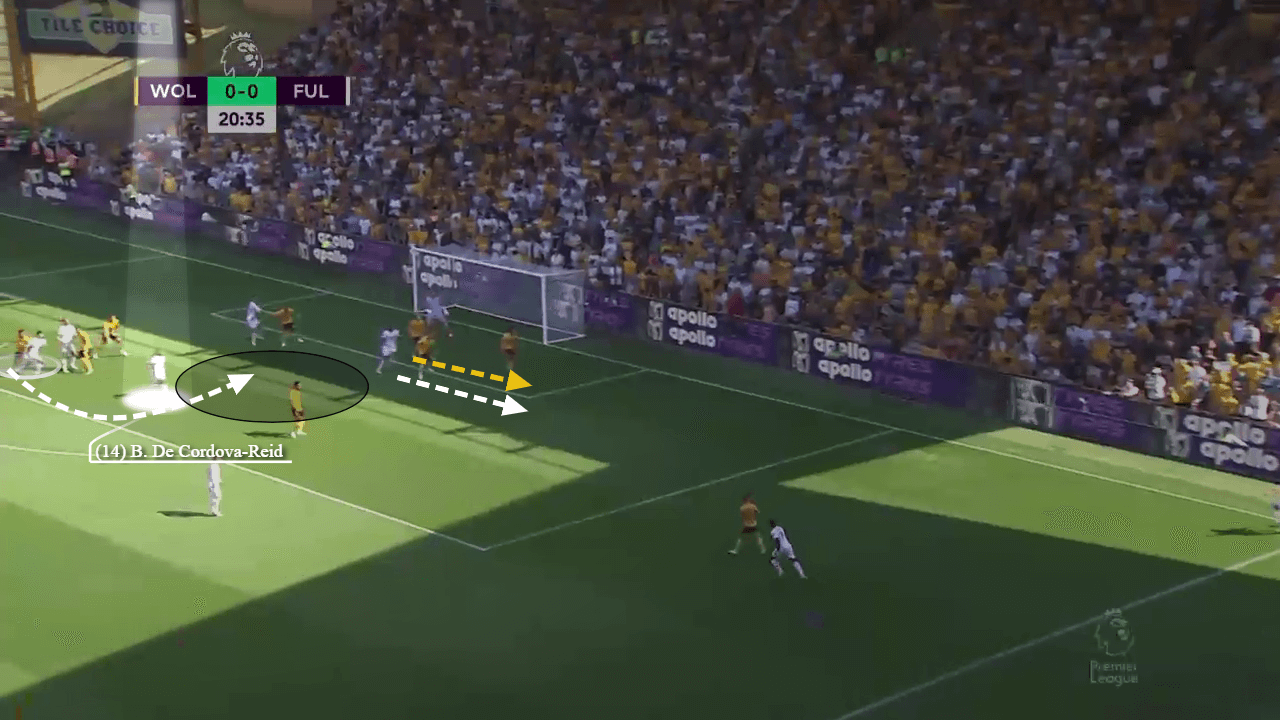
This image below is used to show just how much of a problem Mitrovic can create inside the box, even when he isn’t the target for a cross. While Mitrovic is marked tightly, he still manages to move into the path of a different Nottingham Forest defender, to act as a blocker.
Usually, the original marker of the blocker would rotate and track the run of the spare player, but Mitrovic’s increased threat gives him a sense of gravity where he has taken two defenders out of the game, making life easier for his teammates. This gives Tosin Adarabioyo, who is slightly off-screen to the left, enough time to get away from his marker. In the corner below, Tosin managed to attack the six-yard box unopposed, and score the equaliser thanks to Mitrovic’s block.
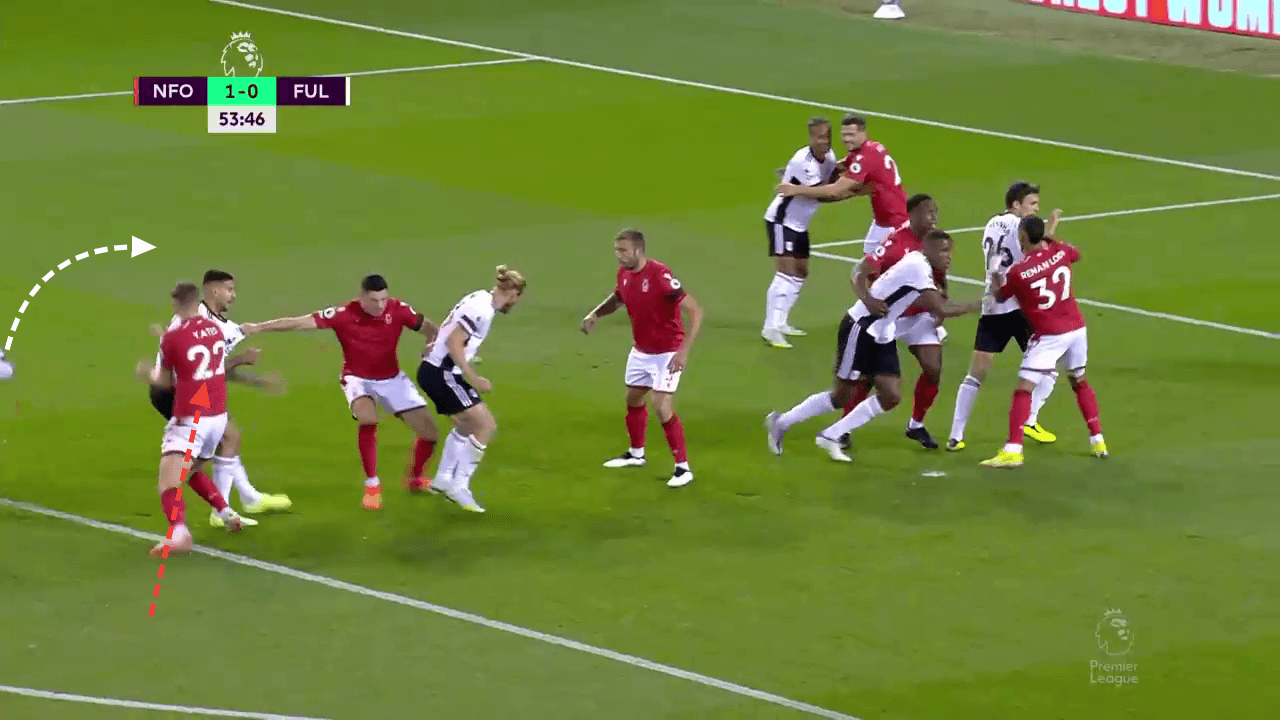
Runs from deep
The use of blockers in the six-yard box has frequently given Fulham’s players opportunities to attack the box from deep. Making a deep run when attacking a corner can be massively beneficial, as the attacking player can gain the momentum needed to get goal-side of his marker, and also use the momentum to outjump his opponent.
In the image below, we can see that Diop has plenty of space to attack the box from deep. The speed of his run also makes it so that it is impossible for his marker to get in the way, as any sort of contact can cause a player to fall when running at a high speed. As a result, Issa Diop has a clear path into the six-yard box, from where Fulham score yet another set-piece goal from what is pretty much an unopposed header.
The use of blockers around the goalkeeper also prevents both the defender and goalkeeper from being able to come out and clear the ball.
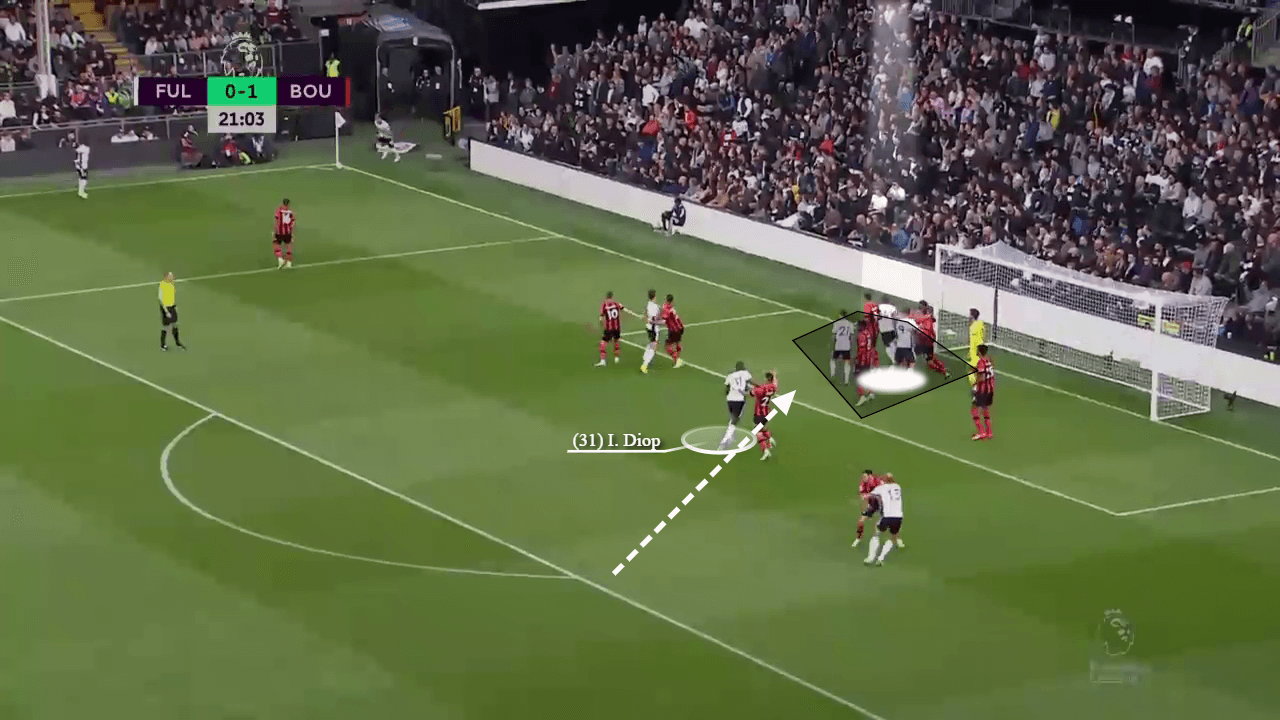
During outswingers, certain teams set up zonal marking further up. In an effort to combat such scenarios, Fulham’s attackers simply start from deeper areas. This allows them to get the run on their markers, making it easier to win aerial duels.
Furthermore, Fulham’s players start slightly behind their markers. As a result, defenders have two options. They can focus on the ball, but lose track of their marker, or they can keep an eye on their opponents but lose track of the ball. In both scenarios, it is extremely difficult for Brentford’s defenders due to the Fulham players having the momentum before getting their head on the ball.
In the scenario below, the defenders focus on the flight of the ball, but Mitrovic uses the speed of his run to outjump the defenders and get another headed effort on goal. Should opponents in the future focus on the players, they will be able to disrupt the run of their marker but will have no idea where the ball is, and be unable to head it away. A mix of the two would be ideal, where a defender can attempt to disrupt the runner, whilst then turning to focus on the ball.
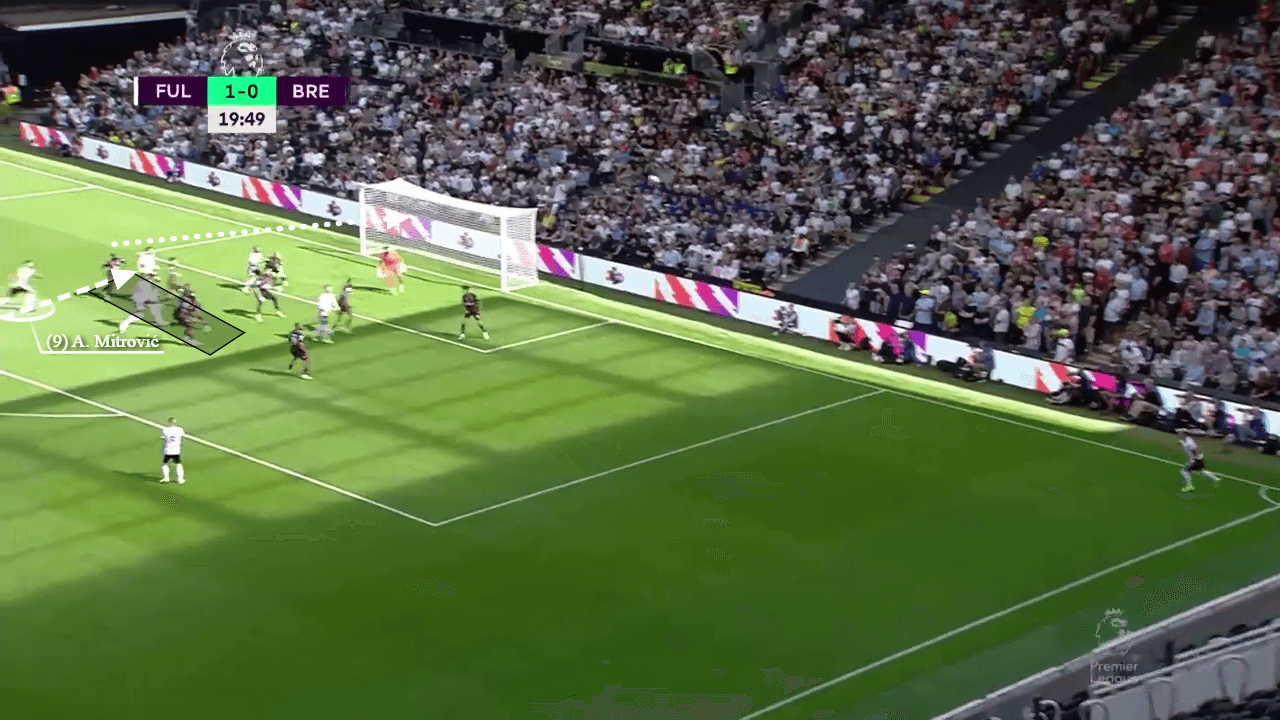
Another use of deep runs can be through the ‘recovery’ zone. This zone is the area outside of the penalty box where players are used to collect rebounds and prevent counterattacks. As a result, players in that zone are usually unmarked or recognised as low priority. What Marco Silva has done is make one of the recovery players drift late into the box, while the rest of the team makes decoy runs into the six-yard box.
This creates lots of space around the penalty spot where Tosin in the scenario below attacks the cross and has a volley, although it is scuffed perhaps due to him being a defender and not comfortable with attempting volleys on goal.
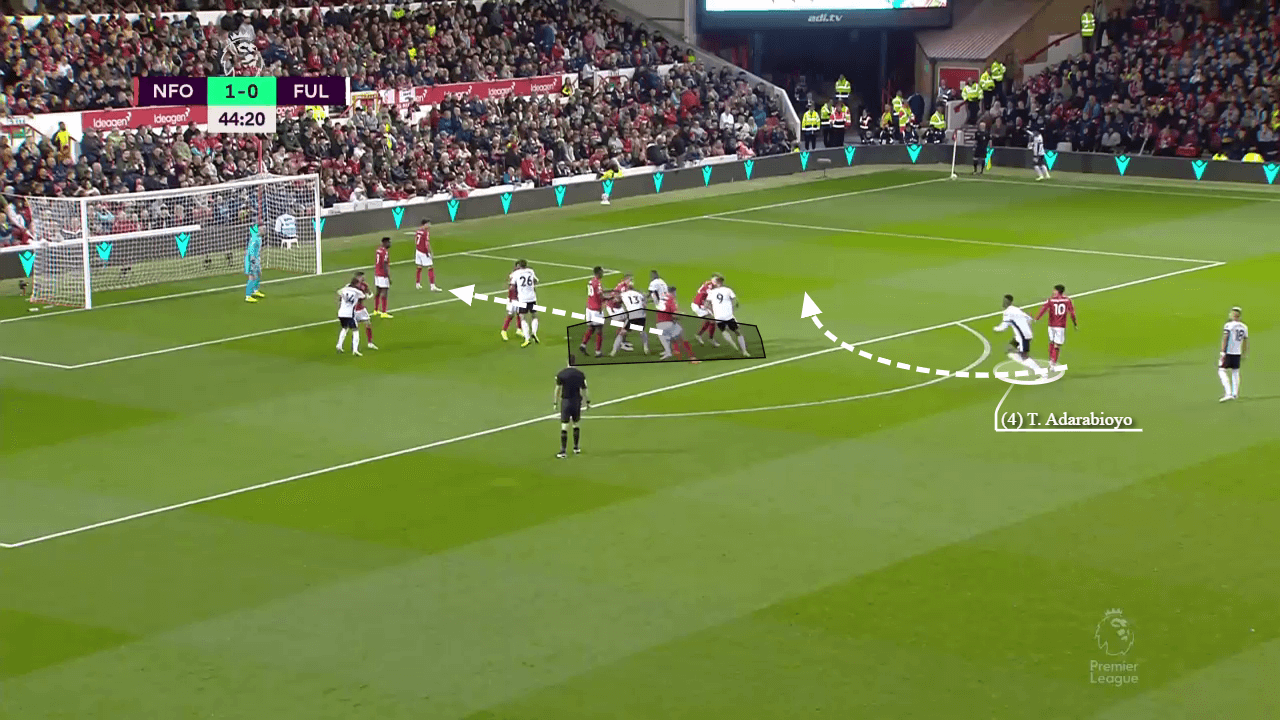
Variety of movements
Fulham keep their opponents on their toes through coordinated movements to open up space for the target player. The target player is almost always Mitrovic.
One method, which has resulted in many good goalscoring opportunities is the use of near post crosses. In these situations, Mitrovic usually starts inside the goal, behind the goalkeeper. It can be difficult to mark a player who isn’t even on the pitch. While he’s in the goal, the near-post player darts towards the ball in order to drag the player at the near post away from the goal. It is usually the role of the front-post defender to follow up a short pass. Wilson is usually in this role where he creates space at the front post and simultaneously can be used to rescue the corner if it is underhit. Then, he can then flick it towards the goal.
As the space at the front post is created, Bobby Reid has a vital role in blocking other defenders from filling that void. He uses his body to stop anyone from getting there, which gives time for the corner to be taken and Mitrovic to arrive at the near post.
This leads to an extremely easy situation where all Mitrovic has to do is head it in from two yards out, and even pressure from his marker from behind won’t be enough to disrupt the shots. This has been attempted on numerous occasions, where in later attempts, teams overload the front post, but as a result, there is more space for other players in different areas of the box.
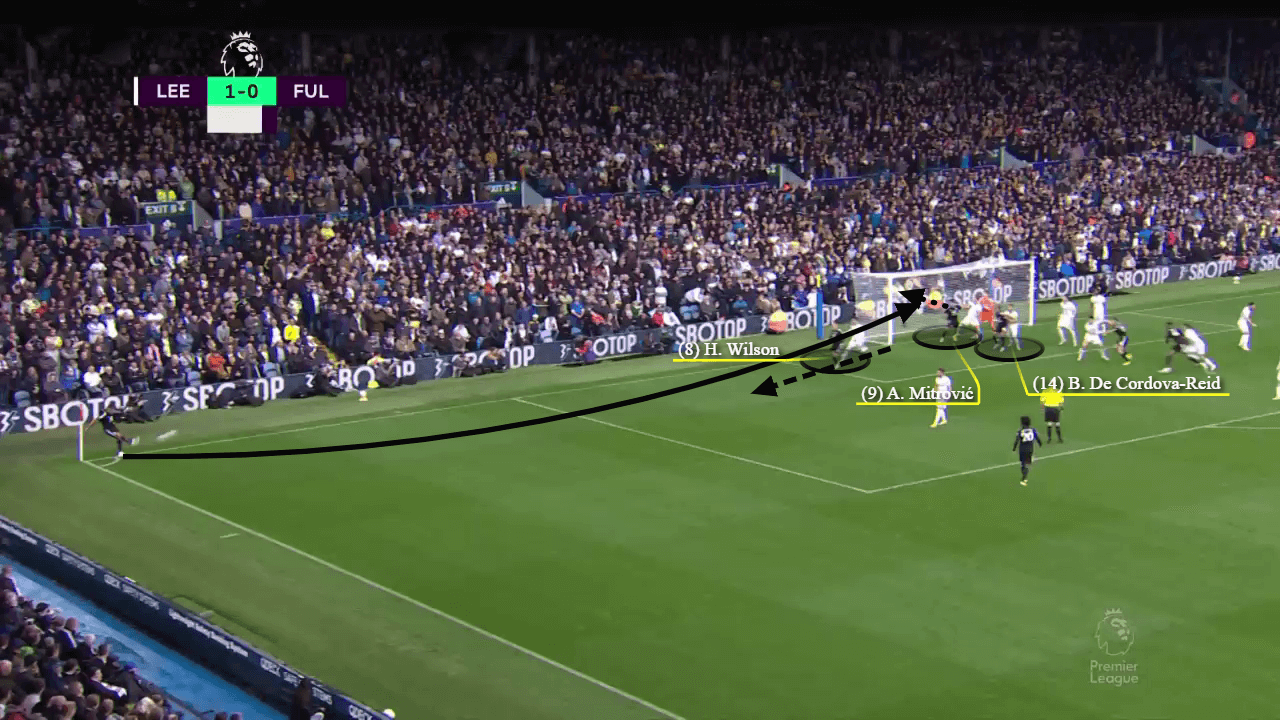
Another smart use of movement is for players to run around large clusters of players. In these situations where everyone is man marking and eight players are all grouped together, one player peels off and uses the rest as a big block.
In this case below, Mitrovic uses a body feint to create separation, before peeling towards the back post. His marker cannot follow him, as he would allow Mitrovic to be goal side, and so he has to run all the way around the other way to try and mark him. In those scenarios, a player focused on the runner has no chance of identifying where the ball is and clearing it. Furthermore, in the example below, Fulham also used Kebano, located in the six-yard box, to block Konsa’s path to Mitrovic, to give him all the time in the world to score his header. This was an extremely intelligent set piece, which was unfortunately blocked on the goal line.
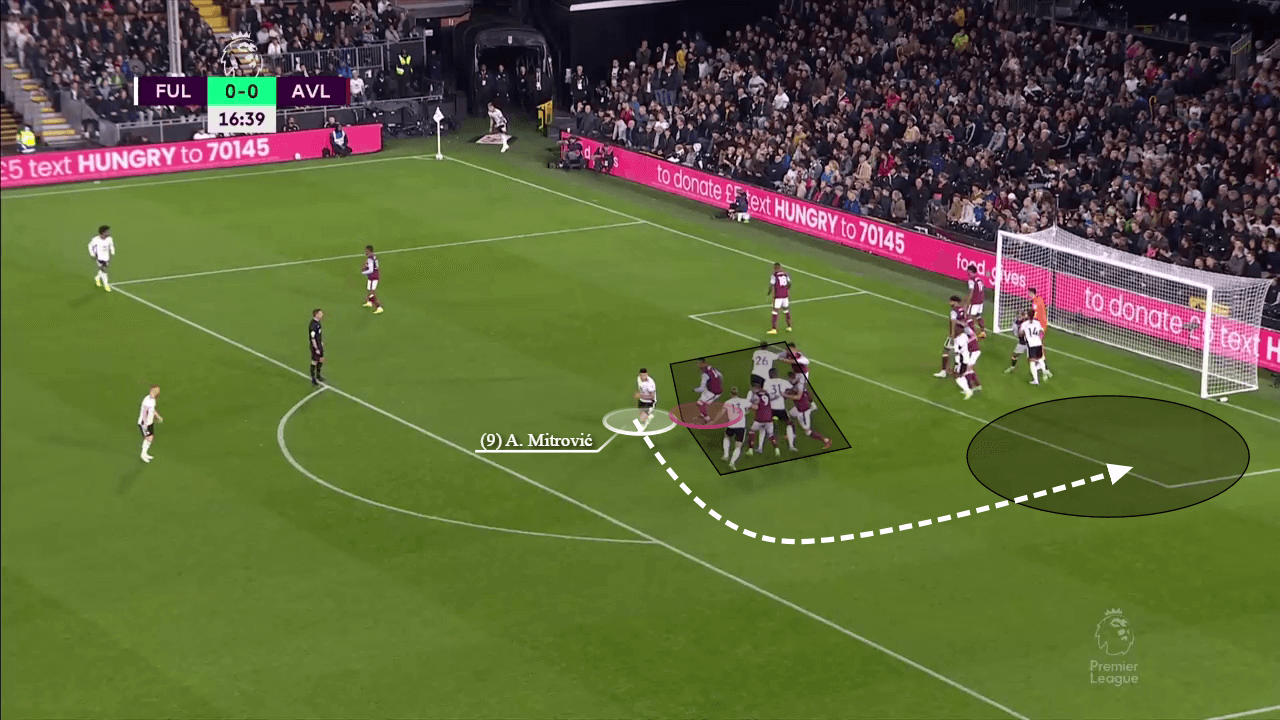
One final way of creating separation through movement is to create blocks naturally. This means that a player’s path is blocked by a normal run from a different player, where both players are still attempting to score, and so the attacking team has lots of options in the box. The way to do this is through opposite movements. We can see in the image below, Ream and Mitrovic run across each other’s paths. As their markers try to follow them, they both interrupt each other and so Mitrovic has space at the back post again to go for the header unopposed.
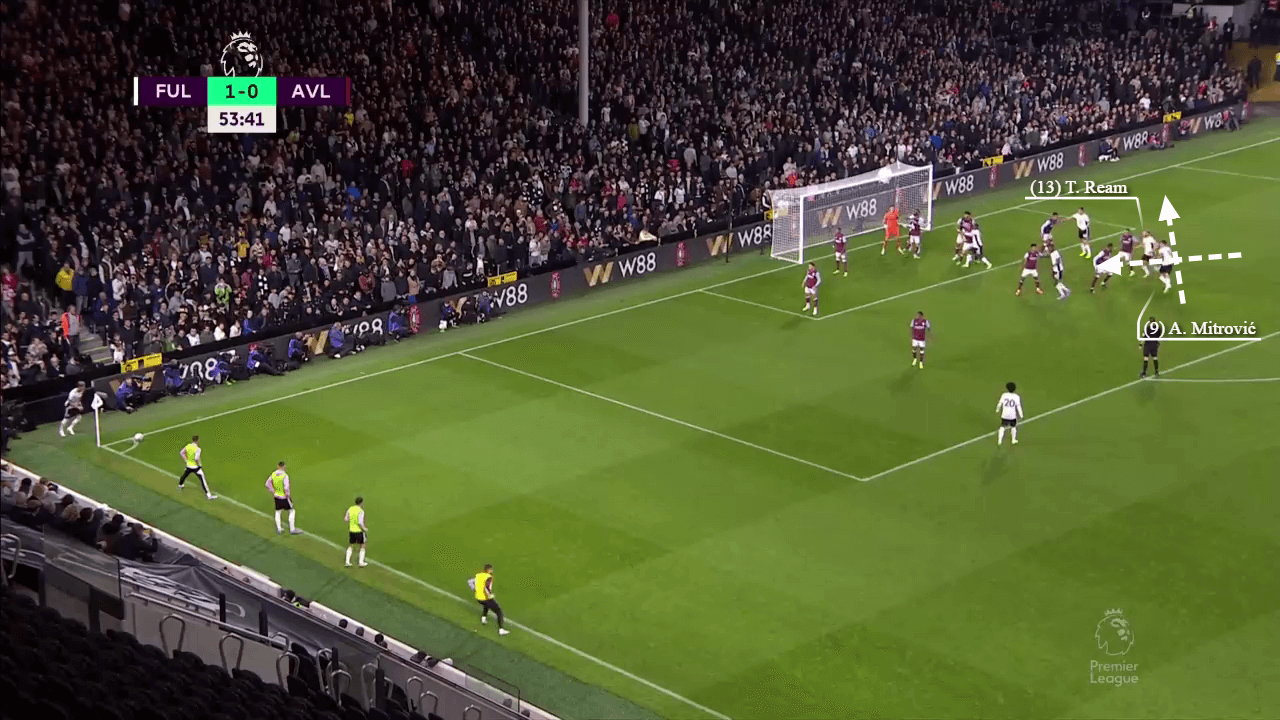
Creativity outside the box
In order to keep their opponents guessing, Fulham have also used players outside the area to be involved in corner routines. Mitrovic hasn’t always been available to Fulham due to injury, and as a result, Fulham opted to make life easier for their other players by allowing them to attack crosses with space in behind. When corners are marked zonally, teams require a greater need for strong headers of the ball due to the deeper areas from which they can be attacked.
One way in which Marco Silva has worked around this problem is to create space in the six-yard box by encouraging the defensive block to step up using short corners. When a corner is played short, teams step up as their body orientation means they would lose track of their runners and so they prefer to increase the distance from where they can attack those crosses. Fulham utilised this by passing it to the edge of the box, from where they can cross it into the space vacated, by making use of Tom Cairney’s half-space crosses.
In the example below, the ball arrives at the back post where it is hard for defenders to backtrack and Tim Ream has an effort on goal which causes David de Gea to pull off a great save.
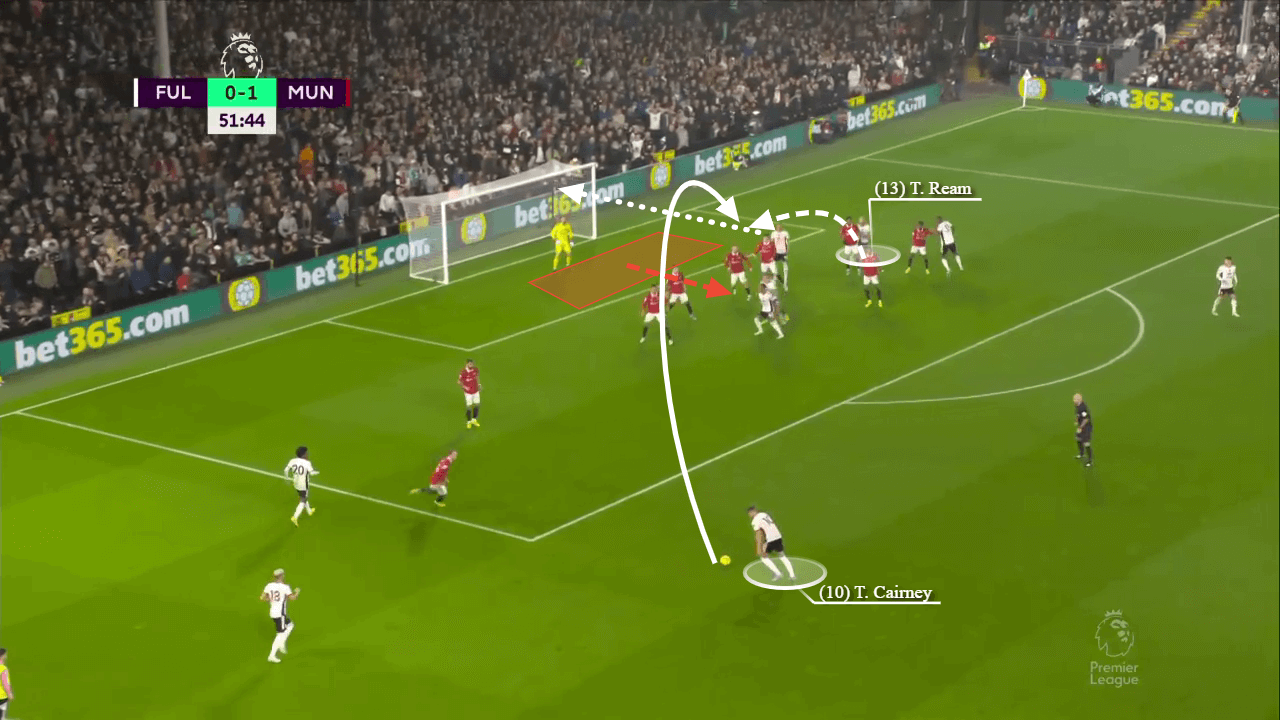
Fulham have also used crosses to the edge of the box to be even more unpredictable. Fulham’s players all attack the front post, which gives Pereira time and space outside the box to pull off a volley. Furthermore, the run towards the near post opens up a shooting lane towards the back post so that Pereira’s volley isn’t easy to block and he can keep it down, increasing his chances of scoring the volley. Meanwhile, Tim Ream knows what is coming and peels off to the back post, in case of any rebounds.
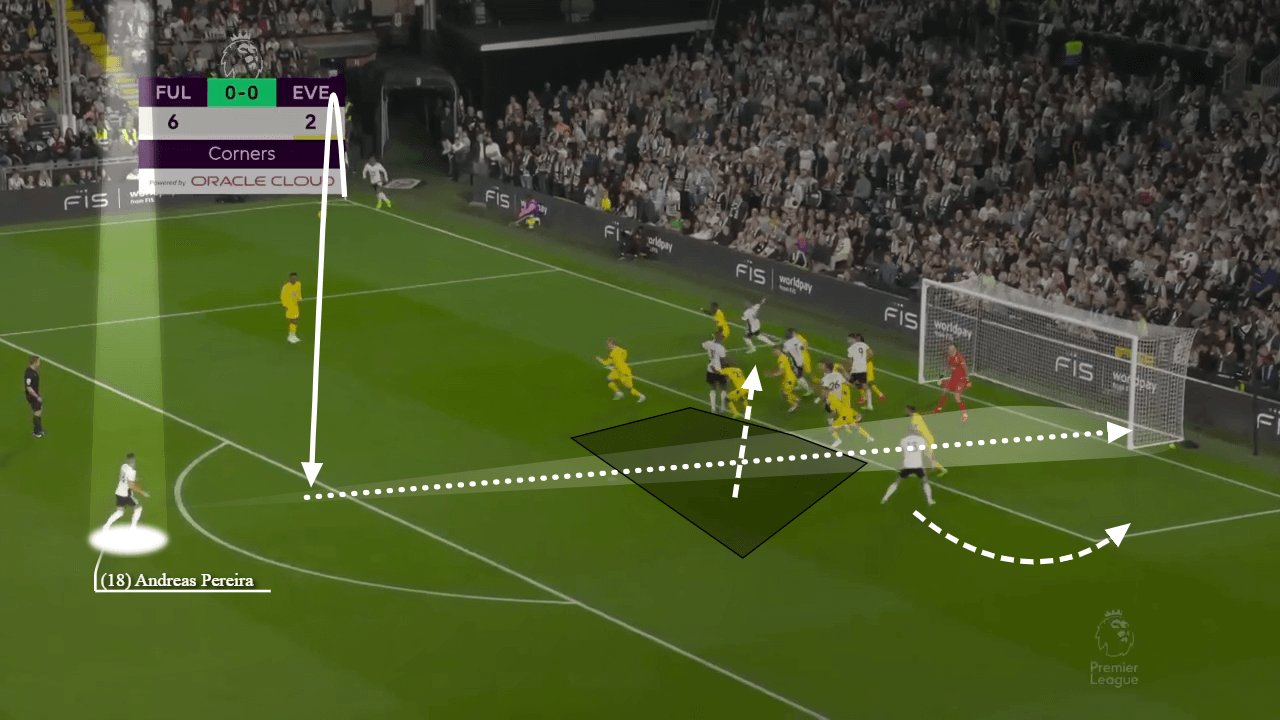
Use of wide free kicks
Fulham have also utilised free kicks from wide areas to create dangerous goalscoring chances. One way in which they have been extremely threatening in attacking the space behind is through their perfect timing of runs.
In the image below, we can Mitrovic begin sprinting as Pereira takes his first step of the run-up, This has been coordinated, so that by the time the ball is kicked, Mitrovic is just breaking through the Brentford defenders, and so he can gain a dynamic advantage as he is attacking the box with a run whilst everyone else was static. This allows him to get to the ball ahead of everyone and attempt an unopposed header on goal.
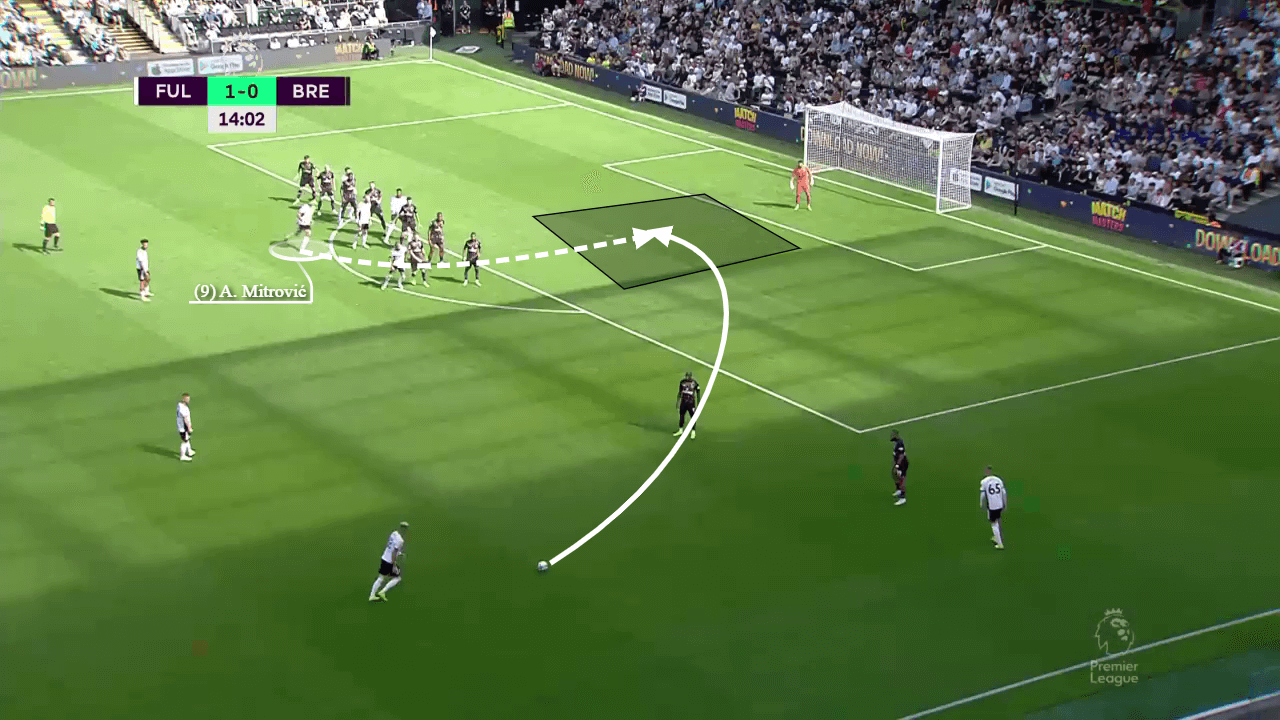
In more advanced areas, where teams defend deeper and there is no space in behind, Fulham have created overloads to be a threat from free kicks. In the example below, Manchester United use zonal marking to prevent any Fulham headers inside the six-yard box. To counter this, Fulham have created a 3v2 overload in the 2nd line. This allows the Fulham players to have a free man who is then picked out by Andreas Pereira and yet again, a Fulham player has a free-headed attempt.
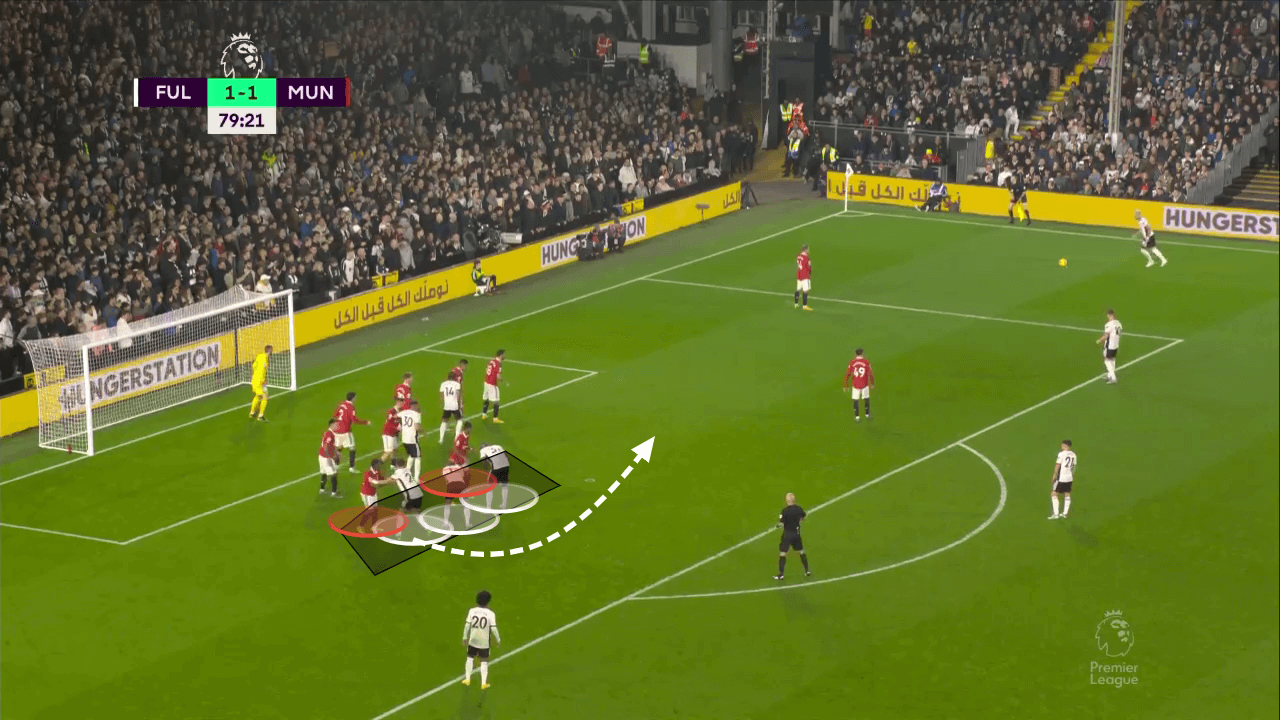
All of these corners and free kicks wouldn’t be possible without the right deliveries of course. The map below shows every shot assist from Andreas Pereira this season. It is clear to see just how many of these come from corners, while there are also a few from wide free kicks. The value in an accurate dead-ball taker can be extremely high, especially for teams who utilise set pieces as much as Fulham.
Pereira’s accuracy from set pieces allows Fulham to try so many different and creative routines, which have proven to be very effective this year.
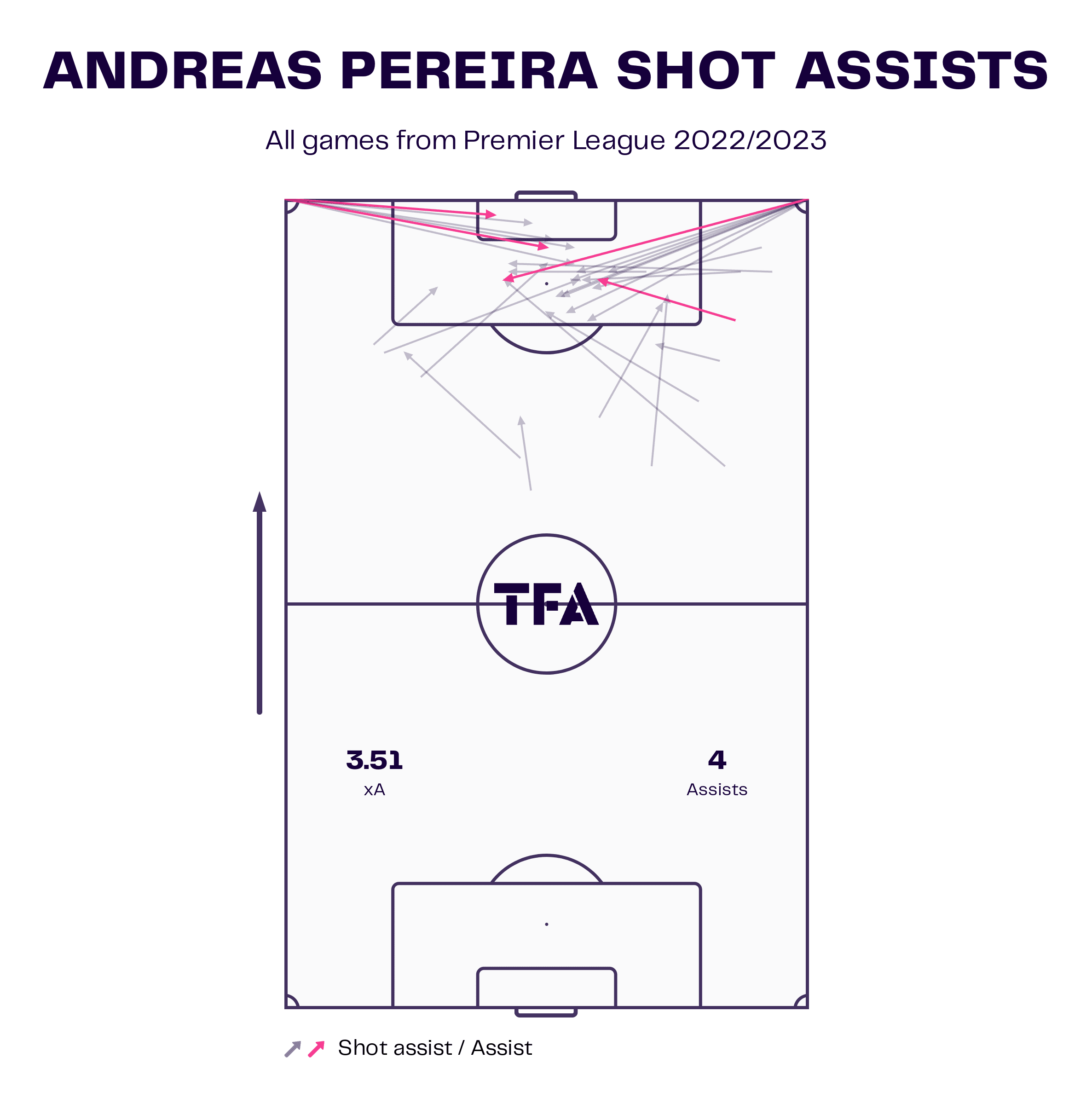
Conclusion
This set-piece analysis has displayed just how much variety Fulham have in their corners and free kicks, and how they are so prepared for any dead ball scenario.
Marco Silva has given each of his players a clear role and these choreographed movements by the Fulham players allow them to frequently attack headers unopposed through brilliant movement and unselfish screens from teammates.
It is hard to predict where each set piece will arrive and defenders are relentlessly dragged all over the place as they try to predict where the delivery might end up.





Comments